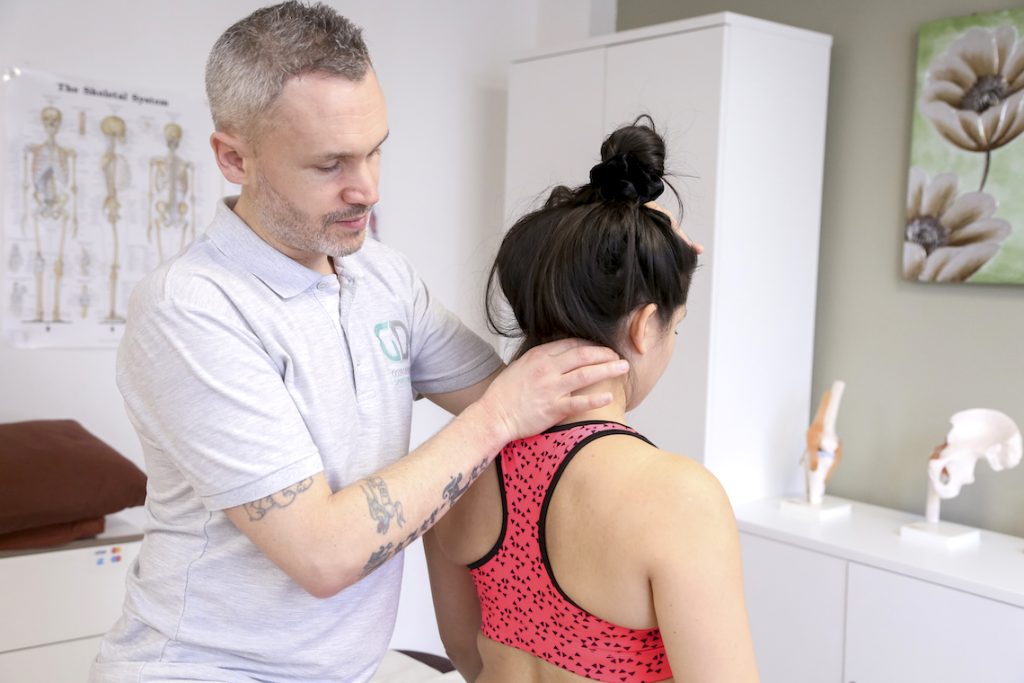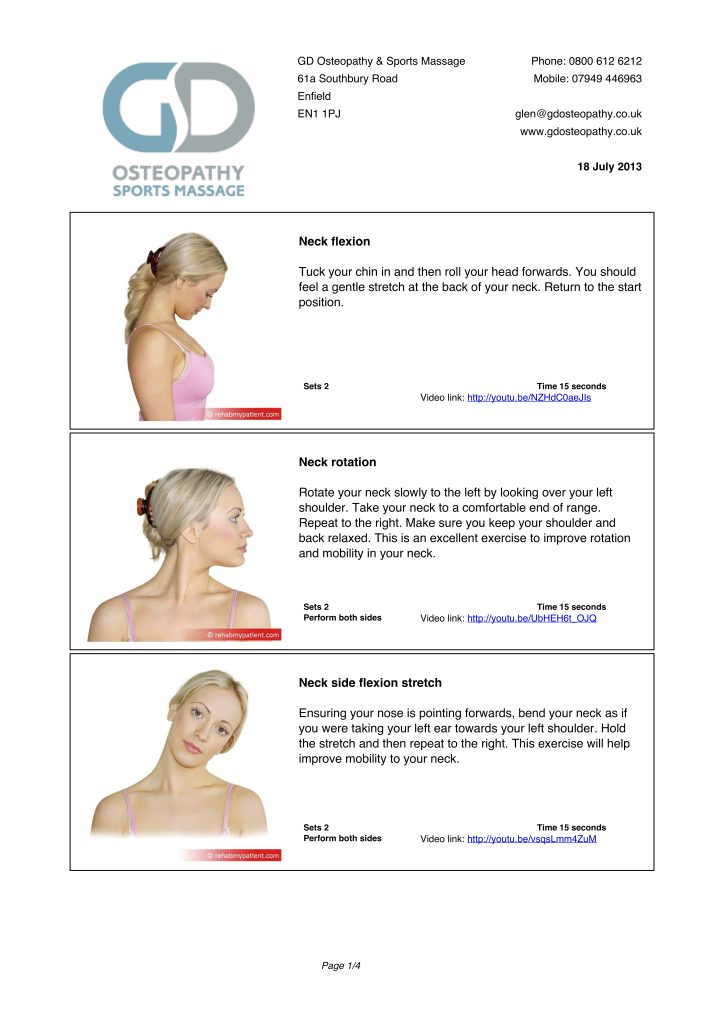The neck or cervical spine contains the first seven vertebrae of the spinal column. The cervical vertebrae supports the head, provides muscular attachment points and provide protection for the vertebral artery and spinal cord which run within the spinal column.
In the middle of each cervical vertebra are nerves, which branch out from the spinal cord through openings in the spinal column. These nerves supply the hands, arms, shoulders, upper back, chest, heart and diaphragmatic regions. Some nerves supply sensory information from the body to the brain, whiles others send out messages to control muscles and other structures.
Poor posture is a major cause of neck pain.
In addition, the lower five cervical vertebrae have between them an intervertebral disc, a tough, fibrous disc with a soft jelly like centre. These discs function to provide shock absorption and stability to the spinal column. There are numerous ligaments and muscles which attach cervical vertebra to cervical vertebra as well as cervical vertebra to head, collarbone, shoulder blades and upper ribs. The ligaments provide support and stability while the muscles generate movement.

The neck and its spinal column have many other important structures associated with it. Being able to pin-point an exact cause of pain or dysfunction, can be difficult for non-healthcare professionals As such, if you are experiencing neck pain you should consult with your osteopath, GP or other allied health professional promptly, so a full assessment and accurate diagnosis can be given.
What Causes Neck Pain?
Torticollis:
This arises when the head becomes partially locked in an abnormal posture i.e. rotated or side bent to one side. It can be very painful to move or even support the head in any other position; there is also significant muscle spasm. There are many potential causes of this condition i.e. minor injury to the muscles, joints, or ligaments of the spine. These injuries can be due to mild trauma or just poor posture while sleeping, working on a PC, phone or tablet. Sometimes torticollis may be due to other more serious conditions
Cervical radiculopathy:
This is when a nerve is injured as it comes out of the spinal cord in the neck. This normally results in some or all of the following:
- numbness in the armpit, shoulder, arm or hand
- pins and needles in the armpit, shoulder, arm or hand
- weakness in shoulder, arm or hand movements
- neck pain
Common causes of radiculopathy include cervical spondylosis, degenerative disc disease, osteophytes, disc herniation.
Non specific neck pain:
This is a common type of neck pain experienced by almost everybody at one time or another. Minor injury, repetitive strain or overuse of the neck and it’s supportive structures can result in pain
Symptoms are often localised to the neck, but there may be some diffuse ache radiating into either the shoulder regions or head. Poor posture either sleeping or sitting can cause nonspecific neck pain; those who sit in static postures for long periods of time or people experiencing stress often experience this issue. However in some cases the exact cause of this neck pain remains unclear. People with nonspecific neck pain may experience:
- Neck pain
- Ache across the shoulder(s)
- Headaches aka cervicogenic headaches
- Muscle tension
- Stiffness
Cervical Spondylosis:
This is a common condition amongst older people; as a result of wear and tear changes to the structures of the neck over many years. The amount of wear and tear that occurs varies from person to person and is sometimes referred to as osteoarthritis of the neck. Structurally the:
- discs between the vertebrae become thinner
- joints between vertebrae become worn
- bony spurs i.e. osteophytes may develop
The above structural changes are found in almost everyone by the age of 65, yet many people experience no or very little neck pain despite these changes.
Whiplash injury:
This occurs when the body travels forwards while the head flips backwards and then as the body stops, the head is thrown forwards. This results in damage to the structures in and around the neck. It occurs most commonly during a car accident where you’re hit from behind, but can also result during sporting activities and falls.
In this type of collision, following a whiplash injury, there is often a delay before the pain and stiffness start. Although whiplash can badly damage your neck, many people who have these accidents do not have major damage and are often better within a few weeks.
More serious causes:
There are numerous more serious causes of neck pain. It is important to seek immediate assessment from your osteopath, GP or other allied healthcare professional if you are experiencing neck pain plus:
- Dizziness or blackouts
- Headaches
- Numbness, pins and needles and / or weakness in your arms or legs

What treatment can I receive?
Minor neck injuries will normally settle down within a couple of days, and do not necessarily need treatment. Nevertheless, if you’re suffering or concerned about your pain, it is advisable that you visit your osteopath, GP or allied health professional to receive a full examination and diagnosis. Early treatment along with appropriate advice can help to reduce the time of recovery, allowing return to work and normal daily activities.
The recommended treatment will depend entirely on the cause of the neck pain. Certain conditions will respond to manual therapy and medications while more severe causes may need surgery or injections.
Osteopathy:
The osteopath will take a detailed medical history, perform a physical examination and then diagnose the injury. An explanation of the injury will be given and a treatment plan recommended. Massage therapy, trigger point therapy, stretching, exercise therapy, joint mobilisation, joint manipulation, electrotherapy (TENS, Ultrasound,
Interferential), hot/cold therapy, taping and postural advice can all be used in isolation or in combination. The type of treatment that will be suggested will vary greatly, your diagnosis, age, underlying health conditions and preferences will all affect the type of treatment you receive.
Medications:
Paracetamol or Co-codamol are common painkillers which may be prescribed by your GP. In addition ibuprofen, diclofenac or naproxen is also commonly prescribed anti-inflammatory medications which will reduce inflammation and reduce pain. Sometimes Diazepam, a muscle relaxant is pescribed for a few days if there is significant muscle spasm.
Injections:
Medications such as cortisone can also be used to manage pain and inflammation, only used if other forms of medications are having no effect.
Cold therapy:
When ice is applied to the skin, the blood vessels in the area narrow. This narrowing reduces blood flow, resulting in reduced swelling and inflammation. The chemicals associated with inflammation cause much of the pain and discomfort. Keeping control over the amount of inflammation in this way will result in less pain and more mobility. It is generally recommended that cold therapy be used 2-5 times a day for 8-15 minutes at a time.
Reusable ice packs, cooling gels or even ICE baths can all be used for this purpose. If using ice cubes, reusable ice packs or frozen peas, it is important not to apply these directly to the skin.
Heat therapy:
When heat is applied, blood vessels dilate and blood flow to the area increases. This results in an increased delivery of nutrients and oxygen to cells in the area, which has been injured. It also aids muscle relaxation and softening of other tissues in the area.
Heat therapy should be avoided in the early acute phase of an injury i.e. when swelling/inflammation is present. Heat applied to an already inflamed area can result in an increase in the underlying inflammation, which can result in more pain, less movement and further damage to the injured tissue. Heat can be used 5-7 days after an injury for 10-20 minutes 2-5 times a day. When applying heat close attention should be taken to avoid burning the skin.
How can you prevent neck pain?
Here are a few recommendations that can help prevent neck pain.
- Try not to slouch when sitting – this increases the load on the discs between the vertebrae and fatigues supportive muscles.
- Avoid looking down at your laptop, phone or table PC – this can overload the muscles at the base of the skull and lead to neck pain and headache.
- Try not to sit or stand in one position for long periods of time – muscles need rest, and movement helps blood circulation.
- Do not sleep on your front – spinal joints are located at the back of the spine, sleeping on your front compresses these joints together. You would be best on your side or back with a supportive pillow.
- Keep objects close to your body when lifting – this is much more efficient and muscles and joints will be more supported.
- RELAX – stress is a common predisposing factor for neck pain.
